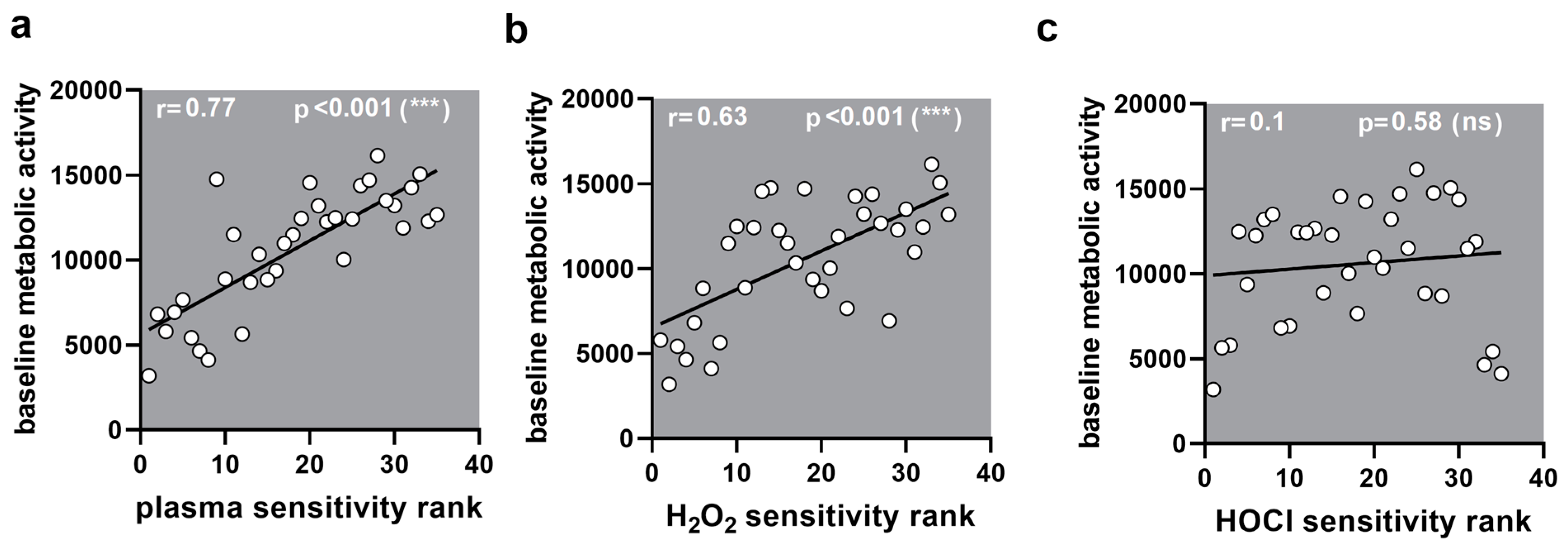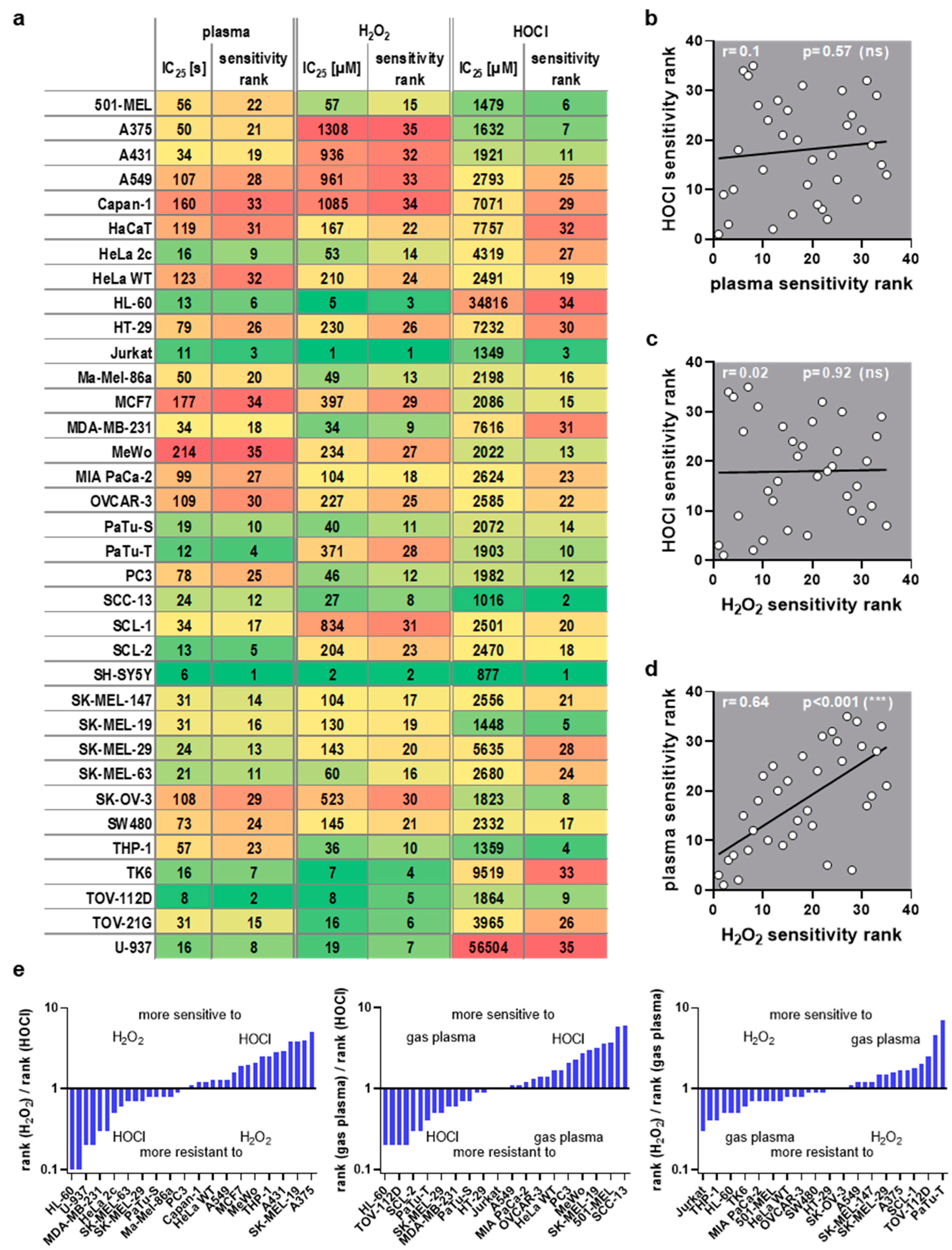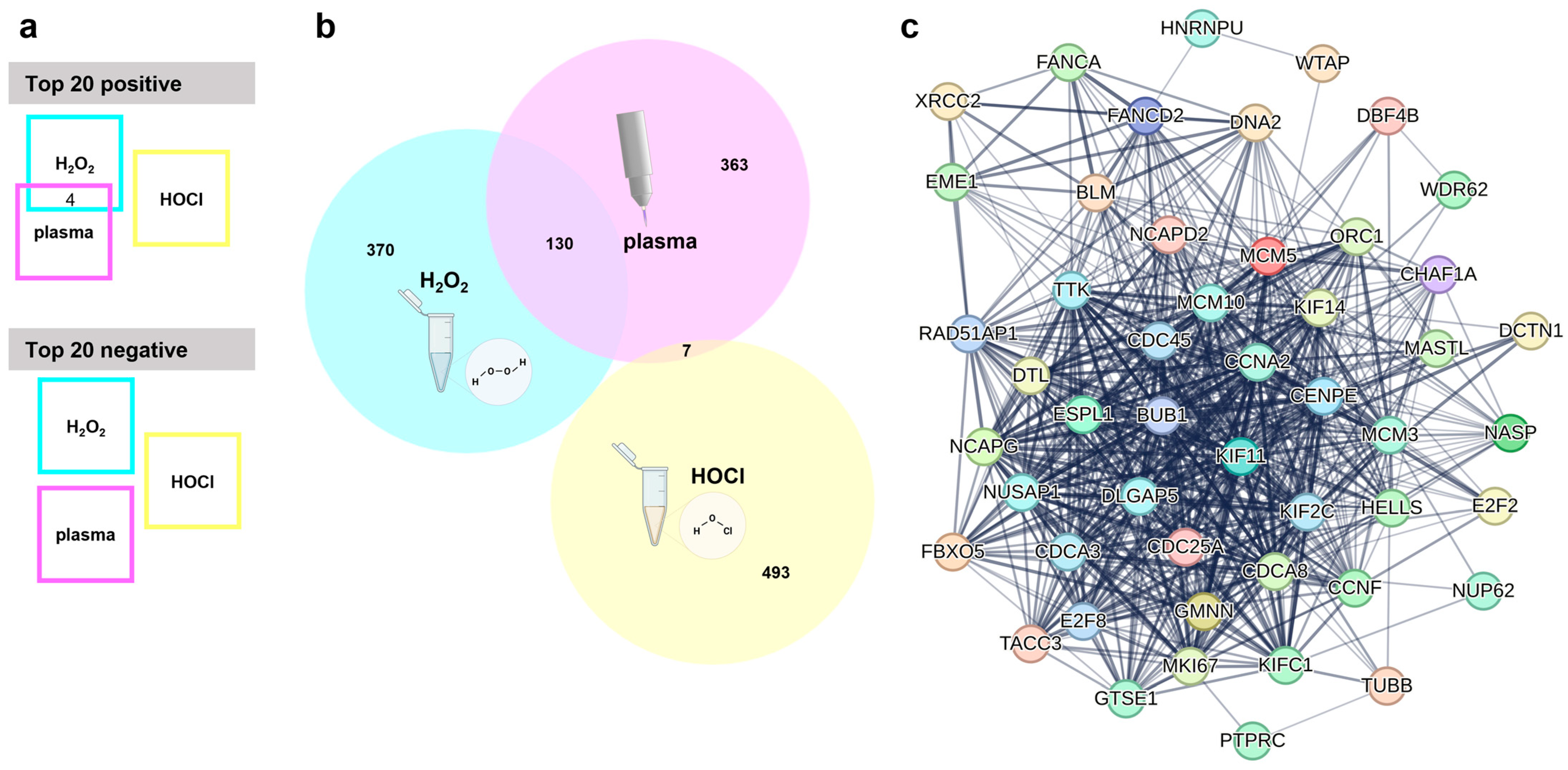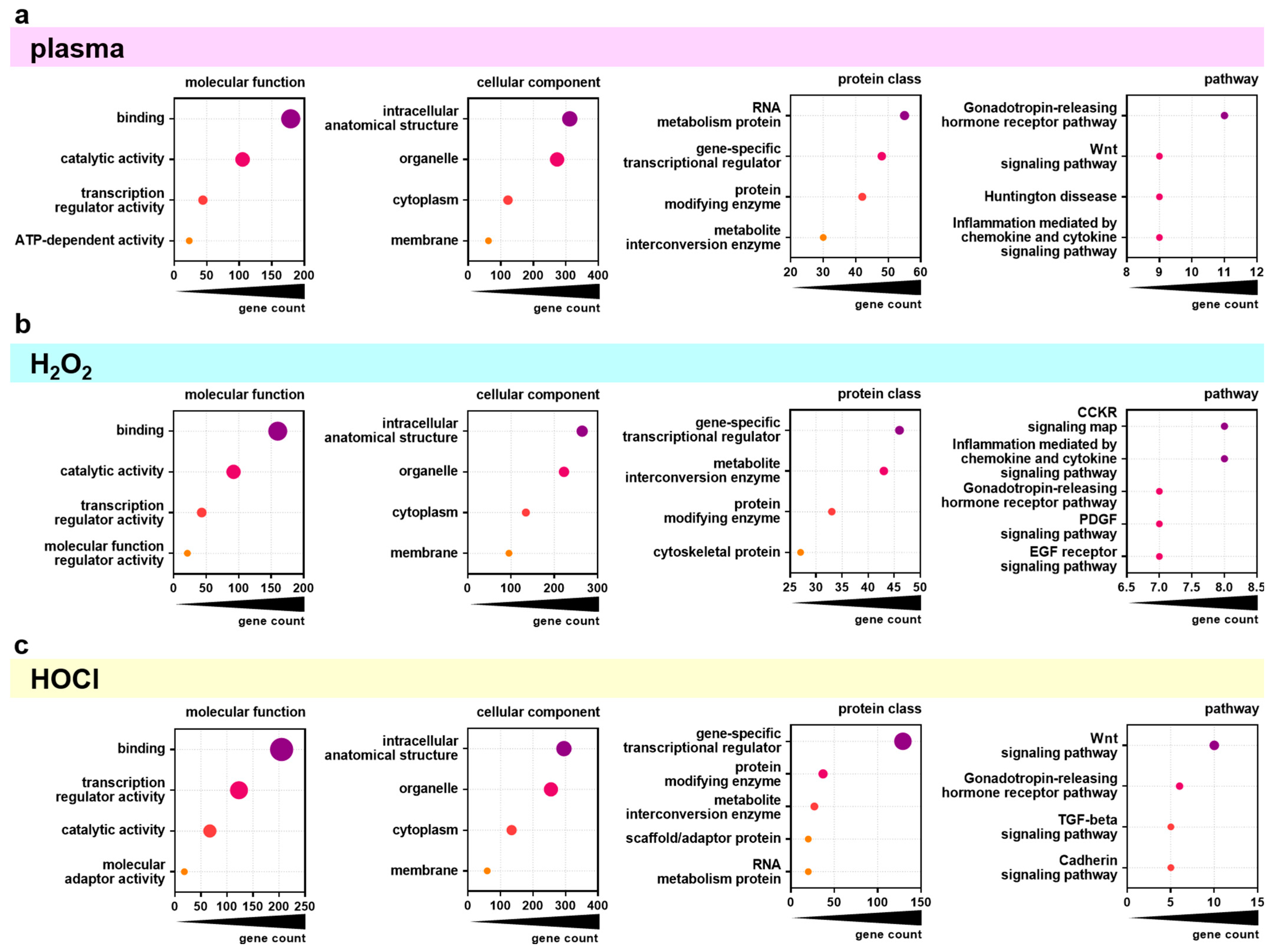Transcriptional Pathways Predisposing to Cancer Oxidative Stress Sensitivity and Resistance Are Shared Between Hydrogen Peroxide and Cold Gas Plasma but Not Hypochlorous Acid
Simple Summary
Abstract
1. Introduction
2. Materials and Methods
2.1. Cell Culture
2.2. Metabolic Activity
2.3. Whole-Genome Transcriptomic Analysis
2.4. Bioinformatic Analysis
3. Results
3.1. Gas Plasma and H2O2 Showed High Correlation While HOCl Cytotoxicity Differed Strongly
3.2. Gas Plasma and H2O2 but Not HOCl Showed Overlapping Genes Associated with Oxidative Stress Sensitivity or Resistance
3.3. Gene Ontology Classification
4. Discussion
5. Conclusions
Author Contributions
Funding
Institutional Review Board Statement
Informed Consent Statement
Data Availability Statement
Conflicts of Interest
Appendix A




References
- Sies, H.; Mailloux, R.J.; Jakob, U. Fundamentals of redox regulation in biology. Nat. Rev. Mol. Cell Biol. 2024, 25, 701–719. [Google Scholar] [CrossRef] [PubMed]
- Sies, H.; Belousov, V.V.; Chandel, N.S.; Davies, M.J.; Jones, D.P.; Mann, G.E.; Murphy, M.P.; Yamamoto, M.; Winterbourn, C. Defining roles of specific reactive oxygen species (ROS) in cell biology and physiology. Nat. Rev. Mol. Cell Biol. 2022, 23, 499–515. [Google Scholar] [CrossRef]
- Yu, W.; Tu, Y.; Long, Z.; Liu, J.; Kong, D.; Peng, J.; Wu, H.; Zheng, G.; Zhao, J.; Chen, Y.; et al. Reactive Oxygen Species Bridge the Gap between Chronic Inflammation and Tumor Development. Oxidative Med. Cell. Longev. 2022, 2022, 2606928. [Google Scholar] [CrossRef]
- Lennicke, C.; Rahn, J.; Lichtenfels, R.; Wessjohann, L.A.; Seliger, B. Hydrogen peroxide—Production, fate and role in redox signaling of tumor cells. Cell Commun. Signal. 2015, 13, 39. [Google Scholar] [CrossRef]
- Winterbourn, C.C.; Kettle, A.J. Biomarkers of myeloperoxidase-derived hypochlorous acid. Free Radic. Biol. Med. 2000, 29, 403–409. [Google Scholar] [CrossRef] [PubMed]
- Snell, J.A.; Jandova, J.; Wondrak, G.T. Hypochlorous Acid: From Innate Immune Factor and Environmental Toxicant to Chemopreventive Agent Targeting Solar UV-Induced Skin Cancer. Front. Oncol. 2022, 12, 887220. [Google Scholar] [CrossRef]
- Galdiero, M.R.; Varricchi, G.; Loffredo, S.; Mantovani, A.; Marone, G. Roles of neutrophils in cancer growth and progression. J. Leukoc. Biol. 2019, 103, 457–464. [Google Scholar] [CrossRef]
- Glorieux, C.; Liu, S.; Trachootham, D.; Huang, P. Targeting ROS in cancer: Rationale and strategies. Nat. Rev. Drug Discov. 2024, 23, 583–606. [Google Scholar] [CrossRef] [PubMed]
- Wardman, P. Chemical radiosensitizers for use in radiotherapy. Clin. Oncol. (R Coll Radiol.) 2007, 19, 397–417. [Google Scholar] [CrossRef]
- Dolmans, D.E.; Fukumura, D.; Jain, R.K. Photodynamic therapy for cancer. Nat. Rev. Cancer 2003, 3, 380–387. [Google Scholar] [CrossRef] [PubMed]
- Bekeschus, S. Medical gas plasma technology: Roadmap on cancer treatment and immunotherapy. Redox Biol. 2023, 65, 102798. [Google Scholar] [CrossRef]
- Bekeschus, S.; von Woedtke, T.; Emmert, S.; Schmidt, A. Medical gas plasma-stimulated wound healing: Evidence and mechanisms. Redox Biol. 2021, 46, 102116. [Google Scholar] [CrossRef] [PubMed]
- Wang, Y.; Qi, H.; Liu, Y.; Duan, C.; Liu, X.; Xia, T.; Chen, D.; Piao, H.L.; Liu, H.X. The double-edged roles of ROS in cancer prevention and therapy. Theranostics 2021, 11, 4839–4857. [Google Scholar] [CrossRef] [PubMed]
- Lorenzen, I.; Eble, J.A.; Hanschmann, E.M. Thiol switches in membrane proteins—Extracellular redox regulation in cell biology. Biol. Chem. 2021, 402, 253–269. [Google Scholar] [CrossRef]
- Bekeschus, S.; Liebelt, G.; Menz, J.; Singer, D.; Wende, K.; Schmidt, A. Cell cycle-related genes associate with sensitivity to hydrogen peroxide-induced toxicity. Redox Biol. 2022, 50, 102234. [Google Scholar] [CrossRef]
- Ai, Y.; Peng, K.; Li, C.; Zhang, J.; Wang, G.; Wang, B.; Huang, E. Assessment of Reference Genes Stability in Cortical Bone of Obese and Diabetic Mice. Diabetes Metab. Syndr. Obes. 2024, 17, 1081–1091. [Google Scholar] [CrossRef]
- Ni, M.; Li, Z.; Li, J.; He, H.; Wang, Y.; Jiang, Y.; Wang, X.; Li, Z.; Li, M.; Xu, H. Selection and validation of reference genes for the normalization of quantitative real-time PCR in different muscle tissues of rabbits. BMC Zool. 2022, 7, 60. [Google Scholar] [CrossRef]
- Chu, Z.Y.; Yang, J.; Zheng, W.; Sun, J.W.; Wang, W.N.; Qian, H.S. Recent advances on modulation of H2O2 in tumor microenvironment for enhanced cancer therapeutic efficacy. Coord. Chem. Rev. 2023, 481, 215049. [Google Scholar] [CrossRef]
- Rizo-Tellez, S.A.; Sekheri, M.; Filep, J.G. Myeloperoxidase: Regulation of Neutrophil Function and Target for Therapy. Antioxidants 2022, 11, 2302. [Google Scholar] [CrossRef]
- Reuter, S.; von Woedtke, T.; Weltmann, K.D. The kINPen-a review on physics and chemistry of the atmospheric pressure plasma jet and its applications. J. Phys. D-Appl. Phys. 2018, 51, 233001. [Google Scholar] [CrossRef]
- Freund, E.; Miebach, L.; Stope, M.B.; Bekeschus, S. Hypochlorous acid selectively promotes toxicity and the expression of danger signals in human abdominal cancer cells. Oncol. Rep. 2021, 45, 71. [Google Scholar] [CrossRef]
- Bekeschus, S.; Kolata, J.; Winterbourn, C.; Kramer, A.; Turner, R.; Weltmann, K.D.; Broker, B.; Masur, K. Hydrogen peroxide: A central player in physical plasma-induced oxidative stress in human blood cells. Free. Radic. Res. 2014, 48, 542–549. [Google Scholar] [CrossRef] [PubMed]
- Miebach, L.; Freund, E.; Clemen, R.; Kersting, S.; Partecke, L.I.; Bekeschus, S. Gas plasma-oxidized sodium chloride acts via hydrogen peroxide in a model of peritoneal carcinomatosis. Proc. Natl. Acad. Sci. USA 2022, 119, e2200708119. [Google Scholar] [CrossRef] [PubMed]
- Ju, H.Q.; Lin, J.F.; Tian, T.; Xie, D.; Xu, R.H. NADPH homeostasis in cancer: Functions, mechanisms and therapeutic implications. Signal Transduct. Target. Ther. 2020, 5, 231. [Google Scholar] [CrossRef] [PubMed]
- Lu, Y.X.; Ju, H.Q.; Liu, Z.X.; Chen, D.L.; Wang, Y.; Zhao, Q.; Wu, Q.N.; Zeng, Z.L.; Qiu, H.B.; Hu, P.S.; et al. ME1 Regulates NADPH Homeostasis to Promote Gastric Cancer Growth and Metastasis. Cancer Res. 2018, 78, 1972–1985. [Google Scholar] [CrossRef] [PubMed]
- Liao, R.; Ren, G.; Liu, H.; Chen, X.; Cao, Q.; Wu, X.; Li, J.; Dong, C. ME1 promotes basal-like breast cancer progression and associates with poor prognosis. Sci. Rep. 2018, 8, 16743. [Google Scholar] [CrossRef]
- Shao, C.; Lu, W.; Du, Y.; Yan, W.; Bao, Q.; Tian, Y.; Wang, G.; Ye, H.; Hao, H. Cytosolic ME1 integrated with mitochondrial IDH2 supports tumor growth and metastasis. Redox Biol. 2020, 36, 101685. [Google Scholar] [CrossRef] [PubMed]
- Paukovich, N.; Xue, M.; Elder, J.R.; Redzic, J.S.; Blue, A.; Pike, H.; Miller, B.G.; Pitts, T.M.; Pollock, D.D.; Hansen, K.; et al. Biliverdin Reductase B Dynamics Are Coupled to Coenzyme Binding. J. Mol. Biol. 2018, 430, 3234–3250. [Google Scholar] [CrossRef] [PubMed]
- Busser, B.; Sancey, L.; Brambilla, E.; Coll, J.L.; Hurbin, A. The multiple roles of amphiregulin in human cancer. Biochim. Biophys. Acta 2011, 1816, 119–131. [Google Scholar] [CrossRef]
- Eckstein, N.; Servan, K.; Girard, L.; Cai, D.; von Jonquieres, G.; Jaehde, U.; Kassack, M.U.; Gazdar, A.F.; Minna, J.D.; Royer, H.D. Epidermal growth factor receptor pathway analysis identifies amphiregulin as a key factor for cisplatin resistance of human breast cancer cells. J. Biol. Chem. 2008, 283, 739–750. [Google Scholar] [CrossRef] [PubMed]
- Andres-Sanchez, N.; Fisher, D.; Krasinska, L. Physiological functions and roles in cancer of the proliferation marker Ki-67. J. Cell Sci. 2022, 135, jcs258932. [Google Scholar] [CrossRef] [PubMed]
- Wang, Y.; Zhong, Q.; Li, Z.; Lin, Z.; Chen, H.; Wang, P. Integrated Profiling Identifies CCNA2 as a Potential Biomarker of Immunotherapy in Breast Cancer. Onco Targets Ther. 2021, 14, 2433–2448. [Google Scholar] [CrossRef]
- Jiang, A.; Zhou, Y.; Gong, W.; Pan, X.; Gan, X.; Wu, Z.; Liu, B.; Qu, L.; Wang, L. CCNA2 as an Immunological Biomarker Encompassing Tumor Microenvironment and Therapeutic Response in Multiple Cancer Types. Oxidative Med. Cell. Longev. 2022, 2022, 5910575. [Google Scholar] [CrossRef]
- Wende, K.; Reuter, S.; von Woedtke, T.; Weltmann, K.D.; Masur, K. Redox-Based Assay for Assessment of Biological Impact of Plasma Treatment. Plasma Process. Polym. 2014, 11, 655–663. [Google Scholar] [CrossRef]
- Akcakaya, H.; Dal, F.; Tok, S.; Cinar, S.A.; Nurten, R. K562 cells display different vulnerability to H(2)O(2) induced oxidative stress in differing cell cycle phases. Cell Biol. Int. 2015, 39, 201–209. [Google Scholar] [CrossRef]
- Burhans, W.C.; Heintz, N.H. The cell cycle is a redox cycle: Linking phase-specific targets to cell fate. Free Radic. Biol. Med. 2009, 47, 1282–1293. [Google Scholar] [CrossRef] [PubMed]
- Chiu, J.; Dawes, I.W. Redox control of cell proliferation. Trends Cell Biol. 2012, 22, 592–601. [Google Scholar] [CrossRef]
- Chua, P.J.; Yip, G.W.; Bay, B.H. Cell cycle arrest induced by hydrogen peroxide is associated with modulation of oxidative stress related genes in breast cancer cells. Exp. Biol. Med. 2009, 234, 1086–1094. [Google Scholar] [CrossRef] [PubMed]
- Waris, G.; Ahsan, H. Reactive oxygen species: Role in the development of cancer and various chronic conditions. J. Carcinog. 2006, 5, 14. [Google Scholar] [CrossRef] [PubMed]
- Perillo, B.; Di Donato, M.; Pezone, A.; Di Zazzo, E.; Giovannelli, P.; Galasso, G.; Castoria, G.; Migliaccio, A. ROS in cancer therapy: The bright side of the moon. Exp. Mol. Med. 2020, 52, 192–203. [Google Scholar] [CrossRef] [PubMed]
- Vilema-Enriquez, G.; Arroyo, A.; Grijalva, M.; Amador-Zafra, R.I.; Camacho, J. Molecular and Cellular Effects of Hydrogen Peroxide on Human Lung Cancer Cells: Potential Therapeutic Implications. Oxidative Med. Cell. Longev. 2016, 2016, 1908164. [Google Scholar] [CrossRef] [PubMed]
- Nakamura, H.; Takada, K. Reactive oxygen species in cancer: Current findings and future directions. Cancer Sci. 2021, 112, 3945–3952. [Google Scholar] [CrossRef] [PubMed]
- Hosseini, M.; Rezvani, H.R.; Aroua, N.; Bosc, C.; Farge, T.; Saland, E.; Guyonnet-Duperat, V.; Zaghdoudi, S.; Jarrou, L.; Larrue, C.; et al. Targeting Myeloperoxidase Disrupts Mitochondrial Redox Balance and Overcomes Cytarabine Resistance in Human Acute Myeloid Leukemia. Cancer Res. 2019, 79, 5191–5203. [Google Scholar] [CrossRef]
- Clemen, R.; Freund, E.; Mrochen, D.; Miebach, L.; Schmidt, A.; Rauch, B.H.; Lackmann, J.W.; Martens, U.; Wende, K.; Lalk, M.; et al. Gas Plasma Technology Augments Ovalbumin Immunogenicity and OT-II T Cell Activation Conferring Tumor Protection in Mice. Adv. Sci. 2021, 8, 2003395. [Google Scholar] [CrossRef] [PubMed]





| Plasma Positive Correlation | Plasma Negative Correlation | ||||
|---|---|---|---|---|---|
| Gene | p-Value | r | Gene | p-Value | r |
| ME1 | 4.39E-05 | 0.63 | PSMC2 | 3.63E-10 | −0.84 |
| CSNK1A1L | 5.65E-05 | 0.63 | GTSE1 | 6.72E-08 | −0.77 |
| DCTN1 | 1.32E-04 | 0.60 | PPP2R3B | 1.23E-07 | −0.76 |
| BLVRB | 2.99E-04 | 0.58 | NAA40 | 2.16E-07 | −0.75 |
| CFAP36 | 6.47E-04 | 0.55 | CEP135 | 3.27E-07 | −0.74 |
| CAPZA2 | 9.08E-04 | 0.54 | SAFB | 4.52E-07 | −0.74 |
| SOCS6 | 1.01E-03 | 0.53 | CXXC1 | 5.03E-07 | −0.73 |
| KRTAP6-2 | 1.07E-03 | 0.53 | MLF1IP | 6.11E-07 | −0.73 |
| AREG | 1.26E-03 | 0.52 | FAM193A | 7.40E-07 | −0.73 |
| ASPH | 1.51E-03 | 0.52 | ILF3 | 7.51E-07 | −0.73 |
| DEPP1 | 1.53E-03 | 0.52 | RBM15 | 1.06E-06 | −0.72 |
| CFAP300 | 1.56E-03 | 0.51 | RBM10 | 1.09E-06 | −0.72 |
| MOS | 1.76E-03 | 0.51 | NOP14 | 1.37E-06 | −0.72 |
| FTHL17 | 1.78E-03 | 0.51 | RBM14 | 1.39E-06 | −0.72 |
| PDK4 | 1.81E-03 | 0.51 | AGAP2 | 1.61E-06 | −0.71 |
| CACNG6 | 1.88E-03 | 0.51 | WDR82 | 1.82E-06 | −0.71 |
| PTGR1 | 1.88E-03 | 0.51 | MCM5 | 2.00E-06 | −0.71 |
| PTCH2 | 1.93E-03 | 0.51 | MYLK2 | 2.11E-06 | −0.71 |
| TMEM52 | 2.31E-03 | 0.50 | SRRT | 2.20E-06 | −0.71 |
| GPR31 | 2.57E-03 | 0.49 | MBD3 | 2.23E-06 | −0.71 |
| H2O2 Positive Correlation | H2O2 Negative Correlation | ||||
|---|---|---|---|---|---|
| Gene | p-Value | r | Gene | p-Value | r |
| RAB26 | 4.65E-06 | 0.69 | SEPTIN6 | 4.80E-07 | −0.74 |
| PERP | 1.20E-05 | 0.67 | NREP | 6.20E-07 | −0.73 |
| ME1 | 1.39E-05 | 0.66 | SIRPG | 1.59E-06 | −0.71 |
| MOCOS | 2.01E-05 | 0.65 | RFTN1 | 4.60E-06 | −0.69 |
| BLVRB | 2.96E-05 | 0.64 | CPXM1 | 8.45E-06 | −0.68 |
| ANXA9 | 3.32E-05 | 0.64 | C4orf46 | 9.29E-06 | −0.67 |
| LCN2 | 4.13E-05 | 0.64 | STMN1 | 9.29E-06 | −0.67 |
| CFAP300 | 4.62E-05 | 0.63 | DTL | 1.07E-05 | −0.67 |
| TPD52L1 | 5.99E-05 | 0.62 | TUBB | 1.26E-05 | −0.67 |
| TOM1L1 | 7.95E-05 | 0.62 | CCDC28B | 1.31E-05 | −0.66 |
| AREG | 8.91E-05 | 0.61 | ZNF692 | 1.97E-05 | −0.65 |
| CFB | 1.03E-04 | 0.61 | PET100 | 3.19E-05 | −0.64 |
| TSPAN1 | 1.04E-04 | 0.61 | BLM | 5.16E-05 | −0.63 |
| KLF4 | 1.19E-04 | 0.60 | CDC25A | 5.59E-05 | −0.63 |
| POLD4 | 1.68E-04 | 0.59 | PLEKHO1 | 6.11E-05 | −0.62 |
| YIF1B | 1.68E-04 | 0.59 | PTGR3 | 6.55E-05 | −0.62 |
| SLC35A3 | 1.93E-04 | 0.59 | SLA | 8.66E-05 | −0.61 |
| MTFR1 | 1.97E-04 | 0.59 | ZKSCAN4 | 9.00E-05 | −0.61 |
| DSP | 1.99E-04 | 0.59 | MCM10 | 9.25E-05 | −0.61 |
| OSGIN1 | 1.99E-04 | 0.59 | H2BW2 | 9.61E-05 | −0.61 |
| HOCl Positive Correlation | HOCl Negative Correlation | ||||
|---|---|---|---|---|---|
| Gene | p-Value | r | Gene | p-Value | r |
| ACSM3 | 3.43E-03 | 0.48 | ZNF777 | 7.22E-05 | −0.62 |
| SLC17A9 | 4.15E-03 | 0.47 | FZD3 | 1.16E-04 | −0.61 |
| BCL2L10 | 6.15E-03 | 0.45 | ZNF23 | 1.18E-04 | −0.61 |
| VASP | 6.15E-03 | 0.45 | ZNF14 | 2.11E-04 | −0.59 |
| RPH3AL | 9.99E-03 | 0.43 | PEX19 | 3.82E-04 | −0.57 |
| ARHGAP18 | 1.13E-02 | 0.42 | ZNF77 | 3.20E-04 | −0.57 |
| LIAS | 1.17E-02 | 0.42 | ZNF606 | 3.84E-04 | −0.57 |
| TNIK | 1.20E-02 | 0.42 | ZNF391 | 4.00E-04 | −0.57 |
| CD86 | 1.24E-02 | 0.42 | ZNF728 | 4.23E-04 | −0.56 |
| PTH2 | 1.43E-02 | 0.42 | MLLT10 | 4.33E-04 | −0.56 |
| SFXN1 | 1.34E-02 | 0.41 | KDM2B | 5.20E-04 | −0.56 |
| EBI3 | 1.43E-02 | 0.41 | TP53BP2 | 5.85E-04 | −0.55 |
| CCL2 | 1.49E-02 | 0.41 | ZNF160 | 6.37E-04 | −0.55 |
| PRAG1 | 1.49E-02 | 0.41 | CLUAP1 | 6.77E-04 | −0.55 |
| HSPA4L | 1.68E-02 | 0.40 | CFDP1 | 7.25E-04 | −0.54 |
| KLK1 | 1.69E-02 | 0.40 | FAM220A | 7.48E-04 | −0.54 |
| ZG16B | 1.95E-02 | 0.39 | ZNF256 | 8.75E-04 | −0.54 |
| MYRF | 2.06E-02 | 0.39 | TULP4 | 8.88E-04 | −0.54 |
| GPAT3 | 2.16E-02 | 0.39 | ZNF175 | 9.85E-04 | −0.53 |
| GPR20 | 2.32E-02 | 0.38 | BOLA1 | 1.02E-03 | −0.53 |
Disclaimer/Publisher’s Note: The statements, opinions and data contained in all publications are solely those of the individual author(s) and contributor(s) and not of MDPI and/or the editor(s). MDPI and/or the editor(s) disclaim responsibility for any injury to people or property resulting from any ideas, methods, instructions or products referred to in the content. |
© 2025 by the authors. Licensee MDPI, Basel, Switzerland. This article is an open access article distributed under the terms and conditions of the Creative Commons Attribution (CC BY) license (https://creativecommons.org/licenses/by/4.0/).
Share and Cite
Singer, D.; Bekeschus, S. Transcriptional Pathways Predisposing to Cancer Oxidative Stress Sensitivity and Resistance Are Shared Between Hydrogen Peroxide and Cold Gas Plasma but Not Hypochlorous Acid. Cancers 2025, 17, 319. https://doi.org/10.3390/cancers17020319
Singer D, Bekeschus S. Transcriptional Pathways Predisposing to Cancer Oxidative Stress Sensitivity and Resistance Are Shared Between Hydrogen Peroxide and Cold Gas Plasma but Not Hypochlorous Acid. Cancers. 2025; 17(2):319. https://doi.org/10.3390/cancers17020319
Chicago/Turabian StyleSinger, Debora, and Sander Bekeschus. 2025. "Transcriptional Pathways Predisposing to Cancer Oxidative Stress Sensitivity and Resistance Are Shared Between Hydrogen Peroxide and Cold Gas Plasma but Not Hypochlorous Acid" Cancers 17, no. 2: 319. https://doi.org/10.3390/cancers17020319
APA StyleSinger, D., & Bekeschus, S. (2025). Transcriptional Pathways Predisposing to Cancer Oxidative Stress Sensitivity and Resistance Are Shared Between Hydrogen Peroxide and Cold Gas Plasma but Not Hypochlorous Acid. Cancers, 17(2), 319. https://doi.org/10.3390/cancers17020319







